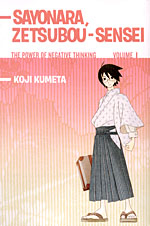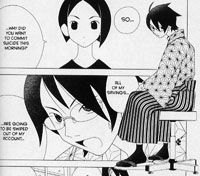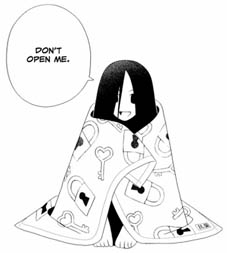 By Koji Kumeta
By Koji Kumeta
192 pages, black and white
Published by Del Rey
There are always times when I really wonder just how much I’m "missing" when reading a translation of a comic into English. Just reading comics that started out in English, it’s easy to see cultural references left and right, ones that even readers from its place of origin might not initially get. So when you’re reading a comic from, say, France or Japan, the chances of missing those cultural references are much higher. That’s something that finally really came home while reading Sayonara, Zetsubou-Sensei Vol. 1; the translator does the best job she can, and there are lots of footnotes at the end of the book, but it’s almost shocking just how much is going to fly over most people’s heads.
Nozomu Itoshiki is a teacher who’s been giving the perfect class. Sure, almost no one else in the school would agree that a class full of misfits and strange kids would be perfect. But for the eternally depressed and suicidal teacher, this group of students is probably all that’s really keeping him alive. (Well, that and his slight incompetence with his suicide attempts.) And just when you think that he’s finally plumbed the depths of strangeness with his students, another one shows up to prove him wrong…
 Sayonara, Zetsubou-Sensei loosely translates into Goodbye, Mr. Despair. For those who have ever seen or heard of the movie Goodbye, Mr. Chips, it’s easy to see the satirical nature of this comic’s title. But really, that’s just the beginning of Koji Kumeta’s satire that runs fast and furious throughout the book. On the simplest level of all, the put-upon school teacher with the oddball class is certainly something we’re all familiar with in comics, especially with manga being translated into English. Sayonara, Zetsubou-Sensei takes it all a step further, though, with each new student being even more ludicrous than the last. It’s a funny take on the subject, and on that level alone it’s certainly enjoyable. Some chapters are punchier than others, although I do think it’s safe to say that there isn’t really a dud chapter in the book.
Sayonara, Zetsubou-Sensei loosely translates into Goodbye, Mr. Despair. For those who have ever seen or heard of the movie Goodbye, Mr. Chips, it’s easy to see the satirical nature of this comic’s title. But really, that’s just the beginning of Koji Kumeta’s satire that runs fast and furious throughout the book. On the simplest level of all, the put-upon school teacher with the oddball class is certainly something we’re all familiar with in comics, especially with manga being translated into English. Sayonara, Zetsubou-Sensei takes it all a step further, though, with each new student being even more ludicrous than the last. It’s a funny take on the subject, and on that level alone it’s certainly enjoyable. Some chapters are punchier than others, although I do think it’s safe to say that there isn’t really a dud chapter in the book.
It wasn’t until I started going through all the footnotes at the back of the book, though, that I began to realize just how much was flying over my head. References to Japanese pop stars who added a star to their name? Train lines known in Japan for regular fatal accidents? A Chinese astrological sign that only shows up once every 60 years and is considered bad luck and creates prejudice? Call outs to a famous female Japanese wrestler? Hopefully you’re starting to get the idea here. Sayonara, Zetsubou-Sensei is just dripping with references that I’d hazard most non-Japanese readers are simply going to fail to get. It’s a little frustrating after the fact, to be honest, because while the initial experience is certainly entertaining, once you discover how much you missed it’s almost as if being told that you’d read an edition of a book that was missing every other page.
 On the other hand, it’s very easy to feel like you’re fully "getting" Kumeta’s art, with its clean, crisp figures. They look almost iconic, everyone formed not so much out of lines but rather out of shapes pieced together perfectly. It’s a really attractive look, going for an uncluttered and simple final product that seems to almost be begging for animation. My sole complaint is that because everyone looks so iconic, there are moments where I really had to look at characters extremely closely to figure out which character had just shown up at first.
On the other hand, it’s very easy to feel like you’re fully "getting" Kumeta’s art, with its clean, crisp figures. They look almost iconic, everyone formed not so much out of lines but rather out of shapes pieced together perfectly. It’s a really attractive look, going for an uncluttered and simple final product that seems to almost be begging for animation. My sole complaint is that because everyone looks so iconic, there are moments where I really had to look at characters extremely closely to figure out which character had just shown up at first.
Honestly, when I got to the end of the first volume of Sayonara, Zetsubou-Sensei, I was surprised to read that there are more volumes to come. Maybe it’s because the final chapter of this volume would serve as a perfect conclusion, maybe it’s because it’s hard to imagine just how many more archetypes Kumeta is going to still be able to drag out of the vaults and onto the page. If I read future volumes, I can’t help but think that the best approach might be to first go through the footnotes and find all the page numbers and add sticky notes to those page. That way, every time I get to a cultural reference I’d be missing, I can flip to the end and see just what it is. On the other hand, that almost might be a fast way to ruining the book with all that extra work and pausing. I can’t help but wonder if the footnotes were absent if I’d have ultimately been happier about the title; it’s certainly a fun book, after all. Just know exactly what you’re getting into before you begin reading for yourself.
Purchase Link: Amazon.com
